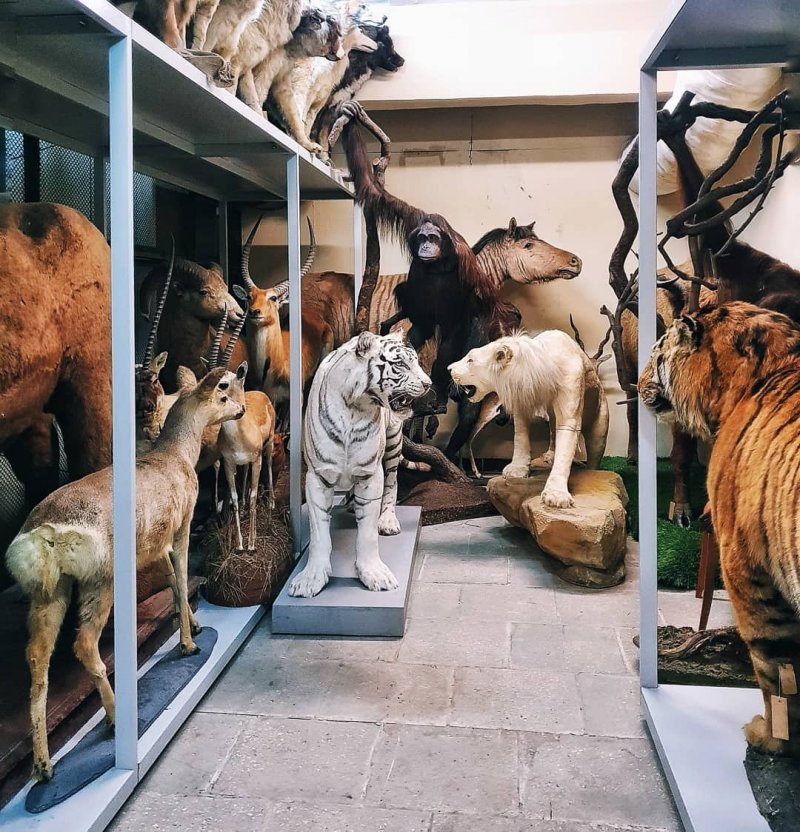Here you can read various interesting stories about Darwin museum collections and the most interesting specimens.
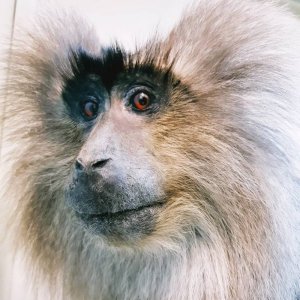
A Monkey or A Lion?
This cute lion-tailed macaque (Macaca silenus) also known as the wanderoo, is an Old World monkey endemic to the Western Ghats of South India. It ranks among the rarest and most threatened primates.A recent assessment for IUCN reports 3000-3500 of these animals live scattered over several areas in Tamil Nadu, Kerala, Karnataka. The spread of agriculture and tea, coffee, teak and cinchona, construction of water reservoirs for irrigation and power generation, as well as human settlements to support such activities has extremely limited the range of the lion-tailed macaques.Unlike other macaques the wanderoo avoid any contact with humans of human culture, therefore the destruction of their natural habitat along with human expansion has led to the drastic decrease of their population.Today in the zoos in various countries there are about 570 of them. But will this be enough and how long will it take to restore the population of the lion-tailed macaques?Their typical lifestyle is arboreal with the diet consisting mainly of indigenous fruits, leaves, buds, insects and small vertebrates in virgin forest. However, it can also adapt to rapid environmental change and broaden its food choices to include fruits, seeds, shoots, pith, flowers, cones, mesocarp, and other parts of many nonindigenous and pioneer plants. In the forests of Kerala, they were observed preying on nestling and eggs of pigeons.The wanderoo are quite creative. For example, they have learned how to peel a fruit completely covered in long sharp spines. Before they can collect it, they twist the fruit until the pedicel can be easily torn. To peel off the skin of the fruit, slightly resembling the fruit of a Chestnut, the lion-tailed macaques scale the spines along their growth not to get hurt.The outstanding characteristic of this species is the silver-white mane, which grows on both males and females. This is how these monkeys got their German name Bartaffe - "beard ape". The other name “the Lion-Tailed Macaque” they received due to a certain trait more pronounces in males - a black tuft at the end of the tail that is similar to a lion's tail.They live in hierarchical groups of usually 10 to 20 members. Being territorial animals, they defend their area with loud cries, chasing away the invaders and rarely engaging in fights. The life expectancy in the wild is approximately 20 years, while in captivity is up to 30 years.
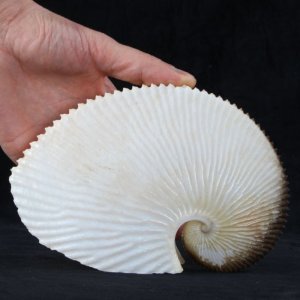
A Paper Nautilus
This unusual specimen is not a mollusk shell. It belongs to the argonauts (genus Argonauta) - a group of pelagic octopuses. The females secrete a paper-thin eggcase, which is why they are also called “Paper Nautiluses”. Apart from the visual resemblance, the eggcase has little in common with chambered nautilus shell: the structure lacks the gas-filled chambers and is not a true cephalopod shell. This is rather an evolutionary innovation unique to the genus Argonauta, which is used as a brood chamber and for trapped surface air to maintain buoyancy. Before laying eggs the female's two greatly expanded dorsal tentacles secrete a laterally-compressed calcareous eggcase in which the female octopus will reside with her eggs. The “shell” is often found floating with the female’s head and tentacles protruding from the opening. When sensing danger she can retreat deeper inside. Another defense strategy is changing color to blend with the surroundings or to eject ink if attacked by a predator. The female can also make a silvery flash by pulling back the web covering of her shell, to deter a predator from attacking. The largest species in the genus - Argonauta argo - produces the largest eggcase, reaching up to 300 mm in length. The smallest species is Argonauta bottgeri, with a maximum recorded size of 67 mm. The big “paper shells” have long been highly valued by private collectors. One of the prettiest is that of the Argonauta argo species, especially due to its pearl-white color. The Chinese call it a “white nest of a seahorse”. These amazing creatures have been of great interest to writers and poets as well. For example, argonauts are featured in Twenty Thousand Leagues Under the Sea, noted for their ability to use their tentacles as sails, though this is a widespread myth. Marianne Moore descrived a female argonaut in the poem "The Paper Nautilus". Anne Morrow Lindbergh named the whole chapter in her 's Gift from the Sea - "Argonauta". Paper nautiluses were caught in The Swiss Family Robinson novel. Argonauts surrounding the Nautilus, in Jules Verne's novel Twenty Thousand Leagues Under the Sea
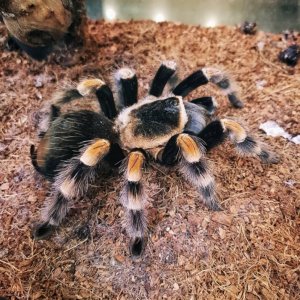
A Spider & A Scorpion
Meet the
fabulous Markosha – a Mexican redknee tarantula (Brachypelma smithi). This
female spider has been living at the Darwin museum “Nature Live Exhibition” for
more than 6 years.It’s
interesting to know, that female tarantulas tend to live a lot longer (up to 20
years and even more) than males, as the latter die relatively soon after
maturing. Apart from that sexual dimorphism is not very pronounced: males tend
to be a little smaller than females, they usually have slightly shorter bodies
and longer legs.Every year
Markosha likes to change her “look”. We get many complaints from our visitors
about spider cannibalism, so we put a sign explaining that it’s not a dead
tarantula, it’s simply an old “outfit” of our spider-lady. The scientific name
for the process of shedding the exoskeleton, which allows spiders to grow, is
called molting. Our Markosha is a mature tarantula who does shedding only once
a year, compared to young who do it more frequently as a part of the growing up
process. An adult tarantula does it to replace lost limbs or lost urticating
hairs. Right before the process begins, Markosha stops feeding and becomes more
lethargic, her exoskeleton takes on a darker shade. If a tarantula previously
used its urticating hairs, the bald patch turns from a peach color to deep
blue.The bite of
a tarantula is unpleasant, but not dangerous for humans. Maybe, that’s why they
are so popular as pets. However, the hairs they brush off when stressed may
cause allergy, so we don’t allow tactile contact with visitors, demonstrating
our lovely Markosha from a safe distance.Our
Markosha belongs to the species of a terrestrial tarantula native to the
Pacific coast of the Mexican state of Guerrero. The natural habitat of the
species is in hilly deciduous tropical forests. It constructs or extends
burrows under rocks and tree roots, among dense thickets and deciduous forests.
The deep burrows keep them protected from predators and enable them to ambush
passing prey. The females spend the majority of their lives in their burrows.
When the tarantula needs privacy, e.g. when molting or laying eggs, the
entrance is sealed with silk, sometimes supplemented with soil and leaves.Another one
extraordinary lady, Markosha’s neighbor, is Naesha – a female scorpion. The two
have something in common – they both are not insects, but belong to the class
Arachnida.Scorpions
are predatory arachnids of the order Scorpiones, who have 8 legs and are easily
recognized by the pair of grasping pedipalps and the narrow, segmented tail,
ending with a venomous stinger. Although, our Naesha has lived with us for
quite some time and has become “domestic”, she is a lady with an attitude,
therefore our visitors can admire her from a safe distance.In 2015 Naesha
became a happy mother of 22 baby scorpions. The size of the litter depends on
the species and environmental factors and can range from 2 to more than 100
scorpions (the average litter is about 8).Unlike the
majority of species in the class Arachnida, scorpions seem to be universally
viviparous, which means that embryos develop inside the body of the parent,
leading the latter to the process of giving birth. Soon after the birth the
young climb onto their mother’s back and get carried around until they have
undergone at least one molt (around 2 weeks). Before the first molt, young
scorpions cannot survive naturally without the mother, since they depend on her
for protection and to regulate their moisture levels. It takes 2-3 years for
them to mature with having to undergo several molts.
Although,
scorpions are not usual inhabitants of cities, their number in industrial and
residential areas has greatly increased for the past several decades due to the
lack of predators, readily available shelter, and abundance of insect prey.
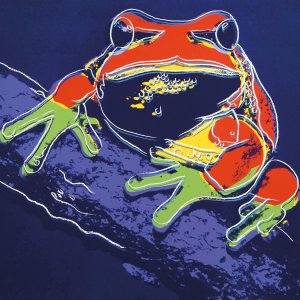
Andy Warhol
Who knew
that there are works by Andy Warhol in the Darwin museum fine art collection!A series of
10 screenprints of rare animals "Endangered Species" was created by
the king of pop art in 1983 at the request of friends, defenders of wild
animals Ronald and Frayda Feldman. It includes portraits of the Siberian Tiger,
Grevy's zebra, Orangutan, Pine Barrens Tree Frog, Giant Panda, Bald Eagle,
Bighorn Ram, African Elephant, the Black Rhinoceros, and the San Francisco
(Callippe) Silverspot Butterfly.Another interesting
fact, the series has an alternative name - "Animals wearing face-paint".
It reflects the way these portraits were made. Warhol selected the most
inspiring photographs of rare animals, and then applied different colors to the
paper through special mesh stencils, layer by layer. Deep bright colors and
their unexpected combinations, as well as a large format (1x1m), draw the attention of viewers to the problem of protecting wild animals.The Endangered Species series was featured in an exhibition at Darwin museum in 2017. These works by Warhol had never been exhibited in Russia before. The exhibition was very popular with Moscow residents - hundreds of selfies with Warhol's works appeared on social networks. After that, the exhibition toured across Russia for several months. Now the works have returned home to the Darwin Museum.
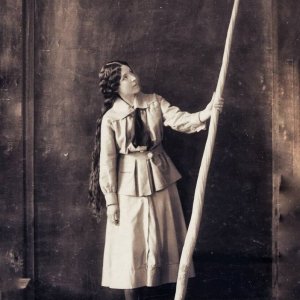
Are Unicorns Real? A Story of a Narwhal
Unicorns are indeed real, although they can be found not in magic forests, but the cold Arctic waters around Greenland, Canada, and Russia. To be correct, it’s not exactly a “unicorn” but rather a “unitooth” – the narwhal (Monodon monoceros), or narwhale, is a medium-sized toothed whale that possesses a large "tusk" from a protruding canine tooth. The narwhal males are distinguished by a long, straight, helical tusk - an elongated upper left canine – which can be up to 2-3 m. long. The second tusk in males and both tusks in females are hidden inside gums and remain undeveloped – a canine tooth. Male narwhals usually develop only one canine tooth on the left side into a tusk. Narwhals with two tusks are very rare – only 1 out of 500. Only about 15% of females grow a tusk which typically is smaller and less noticeable than those of males. Scientists have long speculated about the purpose of the tusk. The suggested versions include its use asa weapon for opening breathing holes in sea ice in feeding as an acoustic organ The leading idea has been the one about it serving as a secondary sex character for nonviolent assessment of hierarchical status. Judging by the size of the tusk it is easy to determine who is “the boss”. One of the more recent studies shows that there might be another more important purpose of this “tooth” – communication. A detailed analysis reveals that the tusk is a highly innervated sensory organ with millions of nerve endings which helps to connect seawater stimuli in the external ocean environment with the brain. Therefore, male narwhals might rub their tusks together to pass the information about the characteristics of the water each has traveled through. Narwhals usually live in groups of 5-10, either nurseries with females and young, or males (called “bulls”) with post-dispersal juveniles. Mixed groups can also appear at any time of year. Narwhals can reach up to 4-5m. in length, excluding the tusk of the male. Its closest living relative is a beluga. They feed mainly on Greenland halibut, polar and Arctic cod, cuttlefish, shrimp, and armhook squid. On the photo of 1911 you can see one of the founders of Darwin museum – Nadezhda Ladygina-Kohts with the narwhal’s tusk. Today the tusk is the part of the museum’s osteological collection. We also have a complete skeleton of a narwhal hanging from the ceiling in our Zoogeography hall on the 3rd floor of the main building. There you can see how big this animal is compared to other animals and humans.
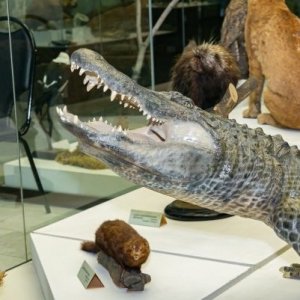
Legendary alligator Saturn
If you go
to the 3rd floor of our main building straight into the Zoogeography
hall and look for the “North American Fauna” display, you will have a chance to
meet a true legend – Saturn the alligator.
American Alligators inhabit freshwater wetlands in the southeastern USA from south Texas to North Carolina. Saturn was born in
Mississippi, the USA in 1936. He was captured the same year and traveled all the
way to Berlin, Nazi Germany. The alligator was put into the Berlin Zoological
Garden, frequently visited by Adolf Hitler. This later gave birth to a popular
rumor that the alligator was Adolf Hitler’s pet. While this is very unlikely to be true, since Saturn
lived at the zoo and was publicly displayed, they probably “met” in person when
Hitler visited the zoo.
In 1943 The
Berlin Zoo was greatly damaged and almost destroyed during the World War II bombardments. Less than
100 out of almost 4000 animals survived the bombing. Saturn was one of the
lucky survivors who escaped the zoo.
After 3
years, Saturn was discovered by British soldiers. It is unknown how did the
alligator live during this time. American alligators can survive
rather cold temperatures. When the water begins to freeze, they go into a
period of brumation. They stick their snouts through the surface, which allows
them to breathe above the ice. They are
also known to dig tunnels to protect themselves from extreme heat and
cold. Probably this was how Saturn managed to survive for these three years.
British soldiers soon gave him away to the Soviets
and the alligator was transported to the Moscow Zoo. Here the alligator was
immediately loved and received the proud name Saturn. He lived in the zoo for
74 years, receiving attention and good care. He loved to eat chum salmon and to be cleaned and massaged with a brush. In
May 2020, Saturn died at the respectable age of 84 and it was decided to donate
the skin of the legendary animal to the Darwin Museum.
The taxidermists
worked on the animal for 6 months. They treated the skin with special solutions
and made a polyurethane foam dummy of the alligator. A skillful taxidermist
Anatoly Alexandrov provided invaluable assistance. At the beginning of
September 2020, the dummy was ready, and a previously treated skin was “fitted”
onto it. On the Darwin museum 113th anniversary, October 7, Saturn appeared
before the public for the first time: the taxidermy mount was ready with a few
final touches to be made. In December 2020 he was permanently installed in Zoogeography hall, where you can see him now and witness a true legend.
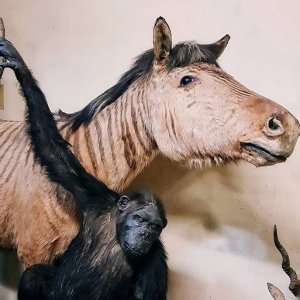
Zebroid – a Horse or a Zebra?
The hybrid of a zebra and any other equine is called a zebroid, aka zorse. This particular one lived a good life at the Moscow zoo, where it had arrived in 1917 from the famous biosphere reserve Askania-Nova.The nature reserve was established in 1898 by Friedrich Jacob von Falz-Fein (1863–1920) around the German colony of Askania-Nova, which only in 1890 became an organized settlement. By the beginning of the 20th century, the founder of the nature reserve managed to turn it into “heaven on earth” with about 2000 different animals inhabiting it.The Russian emperor Nicholas II described this place like this: “there you can find various deers, goats, antelopes, wildebeests or the gnu, kangaroos, and ostriches walking around free under the sky, together. It’s impressive. As if you see a scene from the Bible with all these animals having arrived from the Noah's Ark”.All year round you could watch bisons, saiga antelopes, Przewalski's horses, Turkmenian kulans, donkeys, deers, Ovis ovis, and camels. In summer they were joined by the Ankole-Watusi, the common eland, the African buffalo, the gnu, the nilgai or blue bull, the zebra, and the gayal.The talented zoologist Friedrich Falz-Fein succeeded in breeding Przewalski's horses in captivity. Everything was going so well, that by the early 20th century 52 horses born in Askania-Nova were transferred to European zoos. By the end of 1970s, a small group of Przewalski's horses traveled to the Gobi Desert to recreate the population of wild horses.Today all Przewalski's horses living in zoos are the descendants of the 3 couples from Askania-Nova.Friedrich Falz-Fein had a passion for hybridization, and first of all for crossing various wild odd-toed ungulates. Back then the hybridization was a new science, therefore in 1904, a scientific laboratory was created in Askania-Nova particularly for carrying out experiments on crossing different species of animals.In 1910 the laboratory experiments resulted in creating the first hybrids of a zebra stallion and a horse mare. The offsprings looked like their mother, having stripes on their legs, neck, and body like their father. These hybrids were successfully used in Africa as pack animals or for riding due to being immune to the Tsetse fly bite. However for other countries, the zebroids weren’t as valuable – they were rather aggressive, difficult to train and often born with pathologies.Today we know about 4 zebroids in the World, one of which is called Zanzibar and lives in Russia.








